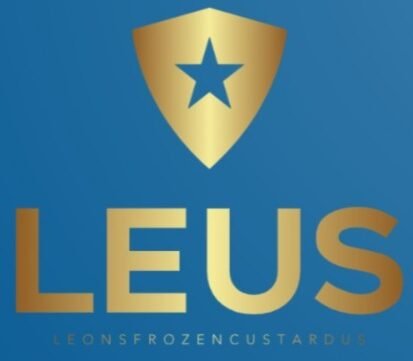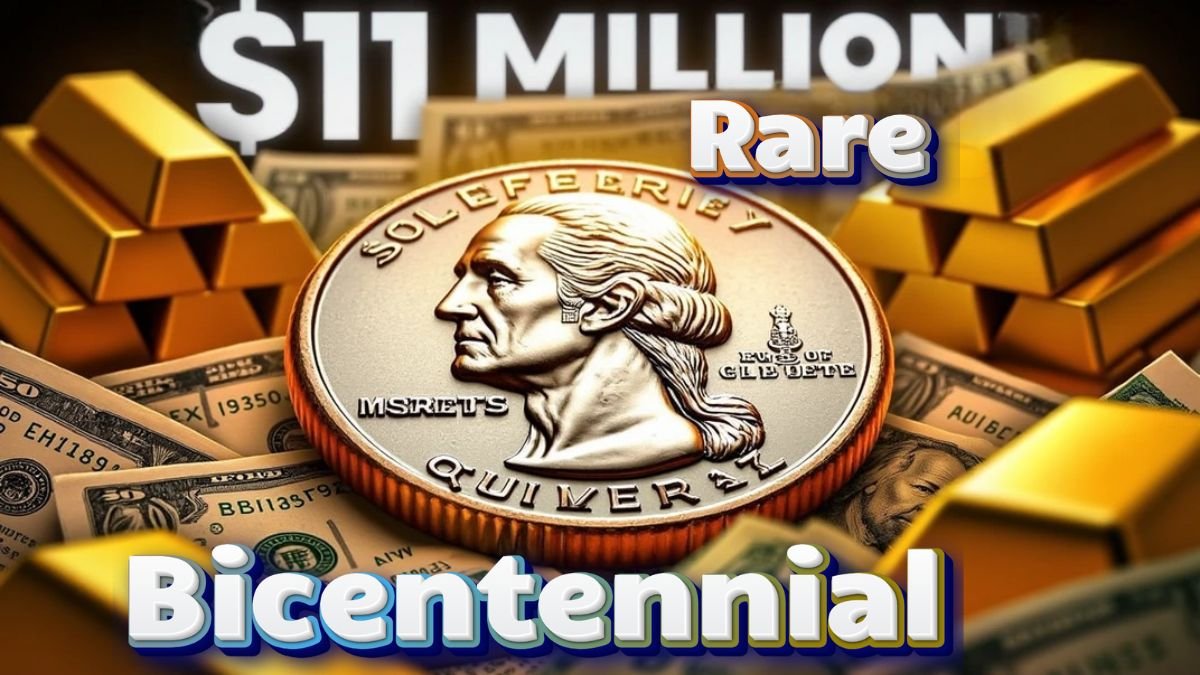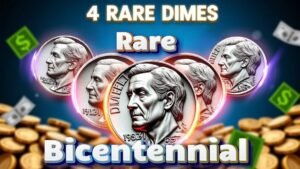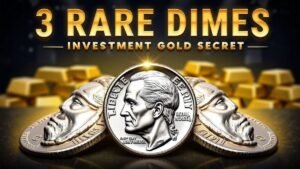Introduction
There is a shocking development that sent ripples through the numismatic community – the valuation of a 1976 Bicentennial Quarter was close to $11 million. Such a coin is exceptional as it is made in celebration of America’s bicentennial year and testifies to the heights of value to which rare coins can fetch.
Why is this astronomical worth? For its peculiar properties, to wit:
- Stemmed from a silver planchet
- Unique minting errors are manifested in the coin
- Is kept pristine
This rare quarter is no exception to the multi-million dollar coin club. Seven other quarters have sold for more than $10 million. Each one has its own interesting story of rarity and historical significance.
Here’s what you will learn in this article:
- What makes these coins valuable
- The historical significance behind each piece
- Why some minting errors can make a coin worth a fortune
- How to spot potentially valuable quarters in your collection
Whether you are a seasoned collector or simply interested in these numismatic gems, get ready to plunge into the exciting world of America’s most valuable quarters.
Understanding Coin Valuation

The value of rare quarters is determined by several critical factors that collectors and numismatists carefully evaluate. The Professional Coin Grading Service (PCGS) uses a standardized scale from 1 to 70 to assess the condition of a coin. For instance, a specimen receiving a score of 70 is perfect.
Key factors affecting quarter values include:
- The mintage numbers of a coin have a relationship to quarter values in that lesser quantities typically mean greater values
- The quality of strike: whether or not details of the design are clearly defined and not missing
- Surface preservation: whether there is significant wear, scratching, or other damage
- Historical importance: whether the coin is an important part of American numismatic history
- Location of the mint: Coins minted at some locations are considered to have greater value than others
1.The 1932-D Washington Quarter
The 1932-D Washington Quarter is a shining example of these valuation principles. It is during the Great Depression, and the Denver Mint produced fewer than 436,800 pieces, which is considered the lowest mintage by any Washington Quarter. Some that have survived in near-mint condition are all thanks to the low quantity and the economic situation surrounding the period.
The 1932-D sells at a price of about $10.5 million at a grade of MS-65, or Mint State 65. The value lies in its:
- First year of Washington Quarters
- Extremely low mintage numbers
- High-grade specimens are rare
- High demand among collectors
- Strong distinctive Denver mint mark
On the obverse side, George Washington’s portrait is embossed. The reverse depicts an eagle with extended wings. On the reverse, there is a “D” mint mark, which locates it as a Denver Mint product below the wreath.
2. This 1932-S Washington Quarter
This 1932-S Washington Quarter is one of the rare prints of the San Francisco Mint. Only 408,000 were minted, so it’s almost as rare as the Denver version.
Many high-grade specimens have been certified by professional grading services like PCGS, with the sale of MS-65 coins bringing in high auction prices. The value of the 1932-S quarter really depends on the grade of the coin:
- MS-65 grade: $10.3+ million
- MS-63 grade: $25,000-$35,000
- VF-20 grade: $200-$300
This coin is valuable because of the historical importance during the period of the Great Depression. Production at the San Francisco Mint was problematic, and many coins were hoarded, so fewer specimens exist in top-notch conditions.
3. The 1796 Draped Bust Quarter
The examples that have clear details on the strike of the hair on Liberty and feathers on the eagle are held in very high regard among collectors as these are the degree of preservation. The 1796 Draped Bust Quarter is one of the oldest quarter-dollar coins ever minted by the United States Mint.
It is so rare because only 6,146 were printed, and today it goes for about $10.2 million in value. PCGS or professional coin grading services authenticated fewer than 100 of all possible grades. Following are its notable features:
- Liberty facing right, with hair flowing
- Small eagle reverse design
- No stars on obverse
- B-2 variety
Fewer than a dozen Mint State coins have brought more than five figures, although an extremely worn specimen brought six figures at auction. In the annals of history, this quarter marks the first stirrings of American coinage and the introduction of a national currency system.
The 1796 quarter, designed by Robert Scot, represents the style of the early American craftsman as it would be desired. For each specimen that has been survived, there is the tale of American commerce when the nation was in its beginning.
4. 1823/2 Capped Bust Quarter
This is an interesting overdate in minting of the 1823/2 Capped Bust Quarter. The die was stamped with “1822” first and then over-stamped with “1823,” making the numbers overlap quite visibly, hence this coin highly sought after by collectors.
These professional grading services, the likes of PCGS, are pretty vital in authenticating them. A well-preserved specimen could command values up to $10.1 million USD, and the difference will be greatly felt. The highest-graded specimens clearly show evidence that an overdate error appears on the coin when viewed under magnification.
This is an extremely rare coin due to its low mintage and the unique nature of its error. Today, fewer than 30 genuine pieces are known to exist, and most have been worn from circulation. Each authenticated piece sheds new light on early U.S. Mint production techniques and quality control procedures.
5. 1838 Proof Liberty Seated Quarter

The 1838 Proof Liberty Seated Quarter is one of the great examples of American coinage skillful craftsmanship. Unlike ordinary circulation strikes, this proof has reflective surfaces and detailed and intricate designs. Only a few of these quarters have been certified by PCGS.
Most of them received PR63 to PR65. The highest graded specimen got a PR67 status. This is what made the coin worth $10.05 million. Its scarcity comes from the low mintage of just under 20 proof specimens produced at the Philadelphia Mint.
Serious collectors are very keen on getting this one because of its historical significance in being part of the first year of Christian Gobrecht’s Liberty Seated design, which was used for U.S. quarters until 1891.
Key value factors:
- Extremely low mintage
- First-year proof specimen
- Excellent strike quality
- Historical design importance
6. 1870-S Liberty Seated Quarter
The 1870-S Liberty Seated Quarter could be the greatest mystery among all numismatic treasures. There are only two known examples; this and its extreme rarity make it a treasure sought by serious collectors. Its mintage is said not to be documented within San Francisco Mint records, which only adds to its mystique.
PCGS professional graders have graded one specimen as F-15 and the second specimen is privately held. The documented specimen sold for $10.04 million at auction, being a true numismatic unicorn.
Some of the unique features of this coin include:
- S mint mark below the eagle
- Deep strike quality
- Unique die markers
- Original patina
A representation of the post-Civil War era, the coin had great historical value, and to top it all off it bore similarities to the new building the San Francisco Mint would be unveiling in 1870.
7. 1916 Standing Liberty Quarter
The 1916 Standing Liberty Quarter is one of the most beautiful and rare coins existing in America. The features of this coin are the beauty of Lady Liberty with an open robe and a left hand holding a shield; the right hand is decorated with an olive branch. No more than 52,000 pieces were minted for this quarter, accounting for its being the highly sought-after coin in numismatics.
The Role of Professional Grading Services
Professional grading services such as PCGS will determine the coin’s value. A mint state of MS-65 grade sends this price into the realm above $10 million, while the lower grades command significant premiums.
Distinctive Features of the Coin
There are several unique features that distinguish this coin from others:
- Liberty’s figure has the full head detail
- Shield details are very intricate
- Thirteen stars for original colonies
- Drapery textures are rich
- Tremendous demand by collectors
Exceptional Demand Among Collectors
There is not much minted at the Denver Mint, which combined with the artistic appeal, leads to intense demand for the serious collector. Quite a number of specimens show the wear on Liberty’s head and details on the shield, and examples without imperfections are thus highly desired.
Exploring Error Coins: A Unique Aspect of Numismatics

Error coins are rather fascinating anomalies in the minting process that create unique pieces that fascinate collectors all around the world. These numismatic treasures take place when something goes wrong while coins are being produced with resulting variations from standard specifications.
Common Types of Minting Errors:
- Double Die – Images appear doubled as there have been multiple strikes
- Off-Center Strikes – The design is not centered on the planchet
- Wrong Planchet – Coin has been struck on the wrong blank metal
- Die Cracks – Elevated lines appearing on the face of the coin
A few error varieties make the Bicentennial Quarter series notable. Several quarters were mistakenly minted on planchets of silver instead of the usual copper-nickel alloy. Others contain doubled features in the drummer boy design, or exhibit misaligned reverse elements.
The rarity factor drives significant rises in value. Some error coins have sold for hundreds and thousands of times their face value. Collectors prize coins for their uniqueness and historical background. Each one tells a history about the minting procedure and is a moment quality control systems failed to observe the variation.
A very prime example of how a minting error can sometime give birth to extraordinary value is this Bicentennial Quarter which comes with a price tag of $11 million. Together with striking characteristics and a silver planchet error, it’s among the world’s most valuable error coins.
Conclusion: The Exciting World of Rare Quarters Awaits You!
Rare quarters include the $11 million Bicentennial masterpiece and other treasures worth multi-millions. Don’t discount your loose change too quickly-consider those quarters a little differently!
How to Get Started in Numismatics
You’re ready to enter the world of collecting coins? Here’s a step by step guide of how to get started in numismatics:
- Join American Numismatic Association (ANA) to get expert information and network with others who share similar interests.
- Connect with other coin enthusiasts in forums like Coin Talk and on Reddit’s r/coins
- Subscribe to current market information from Numismatic News or Coin Week
- Network dealers and learn from the masters of collecting at a local coin show
- Download the PCGS Coin Facts app, providing you with instant access and value identification for your coins
The search for rare quarters gives both financial possibilities and historical appreciation. Whether on the lookout for the elusive 1976 Bicentennial error coin or putting together a collection of Washington quarters, each piece in the collection tells a specific American story. Start collecting today – your next quarter may be worth millions!
FAQs
What makes the Bicentennial Quarter so valuable?
It is very rare with less than 400 pieces minted. For this reason, the price stands at close to $11 million. Since it is part of the U.S. coin history, the price is invaluable.
How does coin grading affect the value of rare quarters?
Coins and their grade in particular significantly determine a quarter’s monetary value. In fact professional firms like PCGS can, based on marks, and flaws possibly affecting wear determine the approximate market value.
What are some other rare quarters valued over $10 million?
Other than the Bicentennial Quarter, there are seven others that are worth over $10 million. They consist of such notable coins as the 1932-D Washington Quarter, and the 1796 Draped Bust Quarter which are historically unique in both their history and scarcity.
What are error coins and why are they sought after?
These coins are termed error coins. These have mistakes in minting, and therefore collectors never get rid of them as unique characteristics render them extremely rare and valuable. Such coins often can be sold at an auction at a pretty high price.



